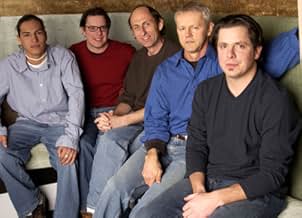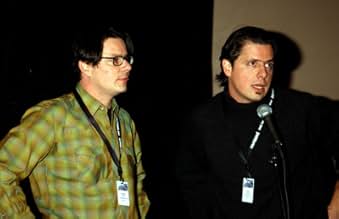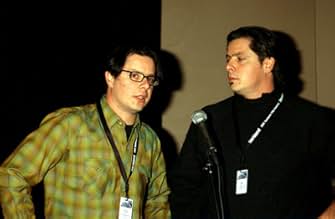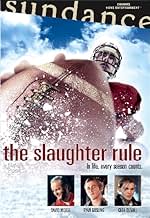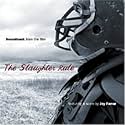NOTE IMDb
5,9/10
2,8 k
MA NOTE
Un jeune homme trouve du réconfort auprès d'une jeune femme, de sa mère et d'un entraîneur de football de lycée qui le recrute comme quart-arrière d'une équipe de six joueurs.Un jeune homme trouve du réconfort auprès d'une jeune femme, de sa mère et d'un entraîneur de football de lycée qui le recrute comme quart-arrière d'une équipe de six joueurs.Un jeune homme trouve du réconfort auprès d'une jeune femme, de sa mère et d'un entraîneur de football de lycée qui le recrute comme quart-arrière d'une équipe de six joueurs.
- Réalisation
- Scénario
- Casting principal
- Récompenses
- 2 victoires et 2 nominations au total
John Henry Marshall
- Matt Kibbs
- (as John Henry Marshall III)
Avis à la une
The Slaughter Rule is one of the few unique films that captivates the viewer straight from the opening sequence. The film opens with a haunting shot, as twin brothers Alex and Andrew Smith take there camera through a barb-wire fence to reveal a helpless dying deer, literally struggling for its every last breath of life. Enter Roy Chutney, a high school student who is cut from the varsity football team just three days prior to losing his estranged father. Much like the deer, Roy never gives up in his struggle to live his life in wake of tragedy, even after losing just about everything that held meaning in his young adulthood. Roy is eventually approached by the local paper distributor Gideon (played with remarkable passion and sustain by the brilliant David Morse). Gideon asks Roy to join his roughneck 6-man football team. Upon joining, Roy is taken under Gideon's wing and must eventually confront the small-town rumors that linger regarding Gideons sexuality, and turbulent past. The Slaughter Rule is unlike any high school football movie ever made. First of all, the film omits any of the standard hallway and classroom scenes that frequent every other film of the genre, It also discards the glorified high school football stadiums that almost give the impression they could be home to the next super bowl. Instead the scenes in this film are mainly set in country bars, private bedrooms, and cold icy fields, where the viewer can almost feel themselves being slammed into the frozen tundra alongside the players themselves. Where most football movies feature strong, good-looking, "prom king" type players, The Slaughter Rule uses gritty, "normal-looking" kids, that could easily be seen tossing the pigskin around in any small middle American town. Eric Edwards stunning cinematography, and alt/country musician Jay Farrar's folk influenced score, help make The Slaughter Rule one of the most promising directorial debuts in recent years, and was by far the best film I saw at the 2002 Lake Placid Film Festival. I strongly urge anyone who has ever experienced loss from death or rejection, to watch this film. For those of you who have not, pull that letterman jacket out of the closet and rent Varsity Blues.
Jesse Haven is a 19 year old film student from Burlington, Vermont Questions or comments?? Email me
Jesse Haven is a 19 year old film student from Burlington, Vermont Questions or comments?? Email me
Ok, so I saw this movie at this year's Sundance, and I was sorely unimpressed. It took a good fifteen minutes of footage before there was an edit or a line of dialogue that made any sense, and it took another 30 minutes before the ham-fisted script gave way to a working plot that wasn't contingent on a close-up of Ryan Gosling's smile or contrived moralizing. After the first 45 minutes however, the script blossomed into a watch-able albeit not completely entertaining or thought-provoking. The highlights certainly include both Gosling and Morse's acting, Gosling being an up-and-coming star, and Morse being an extremely well-established character actor with a good feel for disparate emotions. As a sidenote, after the screening I was talking a little smack about the movie to some of my friends when David Morse walked right behind me--He looks like the nicest guy in the world, but he's a solid 6'2" and probably outweighs me by 50 pounds. I removed my foot from my mouth and promptly changed the subject.
Sometimes technical flaws can get in the way of what otherwise could have been a good story. These movie's flaws prevented me from enjoying it much.
First, two key deleted scenes from the start of the film leave the entire premise feeling hollow. The scenes are offered as a special feature on the DVD. If I were to watch this movie again, I'd play these two deleted scenes where they should have been. First, the scene deleted after the conversation about the teen's father that opens the movie. Second, just minutes later the continuation of a scene talking with the coach in his office.
This has been a growing trend, for directors to cut key scenes that explain things at the start of the movie. In at least commentary tracks directors have said they 'just wanted to get on with the movie'. Well of course they might, since they know the story intimately. The viewer won't, and could use the background to make an emotional connection to the movie. Unless the movie is past the two hour mark, why consider cutting valuable scenes?
Gosling and some of the other performances were great. Of course Gosling does great even in rotten movies like Murder By Numbers.
The wide screen was an overly wide aspect, I guess meant to highlight those beautiful outdoor scenes over the actors. It leaves barely enough room for actors' heads in places, and it made the brief shower scene no fun at all. To echo another comment, the sound was very poor in places. More than accents, it was bad mixing where sound jumped from soft whisphers to loud music then back. My finger ended up fiddling with the volume throughout.
In hindsight, I might watch The Slaughter Rule once, but it won't be worth watching even a second time.
First, two key deleted scenes from the start of the film leave the entire premise feeling hollow. The scenes are offered as a special feature on the DVD. If I were to watch this movie again, I'd play these two deleted scenes where they should have been. First, the scene deleted after the conversation about the teen's father that opens the movie. Second, just minutes later the continuation of a scene talking with the coach in his office.
This has been a growing trend, for directors to cut key scenes that explain things at the start of the movie. In at least commentary tracks directors have said they 'just wanted to get on with the movie'. Well of course they might, since they know the story intimately. The viewer won't, and could use the background to make an emotional connection to the movie. Unless the movie is past the two hour mark, why consider cutting valuable scenes?
Gosling and some of the other performances were great. Of course Gosling does great even in rotten movies like Murder By Numbers.
The wide screen was an overly wide aspect, I guess meant to highlight those beautiful outdoor scenes over the actors. It leaves barely enough room for actors' heads in places, and it made the brief shower scene no fun at all. To echo another comment, the sound was very poor in places. More than accents, it was bad mixing where sound jumped from soft whisphers to loud music then back. My finger ended up fiddling with the volume throughout.
In hindsight, I might watch The Slaughter Rule once, but it won't be worth watching even a second time.
Despite the novelty of its setting, 'The Slaughter Rule' is a fairly conventional coming-of-age tale about a boy who grows into manhood by becoming a member of a ragtag six-man football team. Roy is a teenager trapped in a small Montana town whose life has not been going any too well of late. His father, with whom he had only the most casual of relationships, has been discovered dead on a railroad track, a possible suicide victim. His mother, embittered by their divorce, sleeps around with countless men and has no real inclination to provide her son with any but the most cursory form of maternal affection. On top of all this, Roy has just been rejected for the school's varsity football team because the coach finds him lacking in the kind of 'anger' he feels a player needs to be a success on the gridiron. When Roy is asked by Gid, a somewhat eccentric older man in the town, to come join his six-man football team, the youth only reluctantly acquiesces (six-man football is a near rule-less poor relation to the real game, one ostensibly only played by farm boys). It is at this point that Roy's growth into manhood begins, since it turns out that the enigmatic Gid, who one assumes will be merely a father figure for the affection-starved youth, may be seeking more than just a father/son, athlete/coach relationship with the boy.
This latent-homosexual subtext, in fact, is just about the only element that separates 'The Slaughter Rule' from countless other films in this genre. Most everything else about the film feels derivative and stale: the emotionally distant parents, the promiscuous, psychologically detached mother, the abusive stepdad, the sweet girl who wants to flee this hicksville town as fast and as far as a bus ticket can take her. Towards the end, especially, the filmmakers start to pile up the heartbreaks and tragedies, one on top of the other, almost to epic proportions. One wonders how so much can happen in so short a time to so small a group of people. In the almost two hour running time of the film, only the ambiguity of the Roy/Gid relationship arouses any real interest in the viewer.
Ryan Gosling is tremendously appealing as the troubled Roy, and David Morse (the father in 'Contact') turns Gid into a nicely sympathetic figure. The starkness of the Montana landscape also provides an appropriate backdrop for the bleak melodrama that is playing itself out in the foreground. Apart from these few quality elements, however, there isn't a whole lot else to commend in 'The Slaughter Rule.'
This latent-homosexual subtext, in fact, is just about the only element that separates 'The Slaughter Rule' from countless other films in this genre. Most everything else about the film feels derivative and stale: the emotionally distant parents, the promiscuous, psychologically detached mother, the abusive stepdad, the sweet girl who wants to flee this hicksville town as fast and as far as a bus ticket can take her. Towards the end, especially, the filmmakers start to pile up the heartbreaks and tragedies, one on top of the other, almost to epic proportions. One wonders how so much can happen in so short a time to so small a group of people. In the almost two hour running time of the film, only the ambiguity of the Roy/Gid relationship arouses any real interest in the viewer.
Ryan Gosling is tremendously appealing as the troubled Roy, and David Morse (the father in 'Contact') turns Gid into a nicely sympathetic figure. The starkness of the Montana landscape also provides an appropriate backdrop for the bleak melodrama that is playing itself out in the foreground. Apart from these few quality elements, however, there isn't a whole lot else to commend in 'The Slaughter Rule.'
Having this movie shot in my hometown (Great Falls, Montana), I answered a local casting call for extras. Blink and you'll miss me in the bonfire/party scene. My high school (Great Falls High) was the school used in the beginning of the film, and the locker room the team is in happens to be the girl's locker room. David Morse's character lives above a vacuum place downtown. The hospital in the movie used to actually be the old Colombus hospital, but is now a office building.
The twins in the movie (Matt and Paul Pippinich), I went to school with for 7 years, and that old orange truck is theirs. Matt played clarinet in a dixieland jazz band.
When I saw this movie at the Wilma theater in Missoula, MT, one of the directors was there to answer questions. He said that they chose Great Falls (pop. approx. 60,000) for shooting "because it was sort of the town that time forgot." In some ways, this is true, but the city is not as run down and rural as it appears in the movie.
Overall, I found myself enjoying this movie more for the "hey, I know him!" or "I lived 2 miles from there" situations. While this wasn't a movie that I would want to watch repeatedly, I still highly suggest it for rental. It's more than just a "sports" movie.
Also, a stellar soundtrack that makes the movie that much better.
The twins in the movie (Matt and Paul Pippinich), I went to school with for 7 years, and that old orange truck is theirs. Matt played clarinet in a dixieland jazz band.
When I saw this movie at the Wilma theater in Missoula, MT, one of the directors was there to answer questions. He said that they chose Great Falls (pop. approx. 60,000) for shooting "because it was sort of the town that time forgot." In some ways, this is true, but the city is not as run down and rural as it appears in the movie.
Overall, I found myself enjoying this movie more for the "hey, I know him!" or "I lived 2 miles from there" situations. While this wasn't a movie that I would want to watch repeatedly, I still highly suggest it for rental. It's more than just a "sports" movie.
Also, a stellar soundtrack that makes the movie that much better.
Le saviez-vous
- AnecdotesScreenplay was developed in the Sundance Lab.
- GaffesThe microphone that the yodeling band gather round is a Sennheiser MD441, which has a tight, end-on pickup pattern. Singing into it sideways as they are, the would hardly have been picked up.
- Citations
Roy Chutney: My father told me if I was hard enough, I wouldn't break. He lied. Everything breaks.
- ConnexionsFeatured in The 2003 IFP Independent Spirit Awards (2003)
Meilleurs choix
Connectez-vous pour évaluer et suivre la liste de favoris afin de recevoir des recommandations personnalisées
- How long is The Slaughter Rule?Alimenté par Alexa
Détails
Box-office
- Budget
- 500 000 $US (estimé)
- Montant brut aux États-Unis et au Canada
- 13 411 $US
- Week-end de sortie aux États-Unis et au Canada
- 1 461 $US
- 12 janv. 2003
- Montant brut mondial
- 13 411 $US
- Durée1 heure 52 minutes
- Couleur
- Mixage
- Rapport de forme
- 2.35 : 1
Contribuer à cette page
Suggérer une modification ou ajouter du contenu manquant

Lacune principale
By what name was The Slaughter Rule (2002) officially released in India in English?
Répondre



